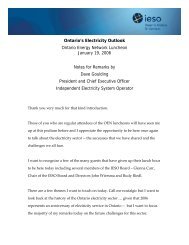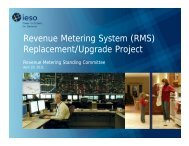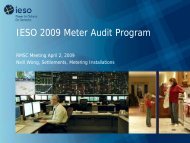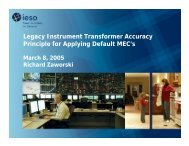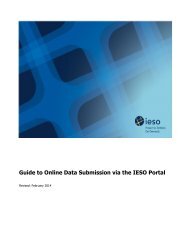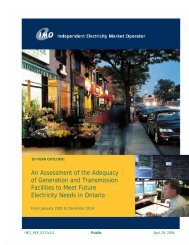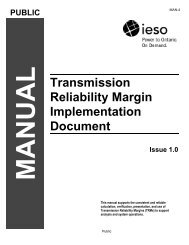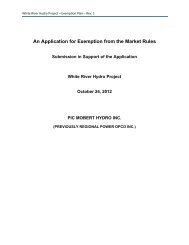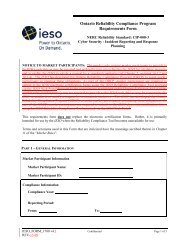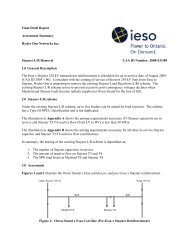Participant Technical Reference Manual - IESO
Participant Technical Reference Manual - IESO
Participant Technical Reference Manual - IESO
Create successful ePaper yourself
Turn your PDF publications into a flip-book with our unique Google optimized e-Paper software.
<strong>Participant</strong> <strong>Technical</strong> <strong>Reference</strong> <strong>Manual</strong><br />
3. Dispatch Information<br />
3.4 Voice Communication Specifications<br />
228 Voice communications are broken into two categories:<br />
Normal-priority path market participants; and<br />
High-priority path market participants.<br />
229 The determination for whether a market participant requires a High Priority<br />
path is defined in the “Market Rules” Appendix 2.2. Regardless of the status of<br />
the market participant, all calls will be „caller identified‟ and handled through<br />
confidential links between sites. All calls involving <strong>IESO</strong> operations will be<br />
recorded by the <strong>IESO</strong> and must be responded to as set out in the market rules.<br />
230 In either category, voice communications between the <strong>IESO</strong> and market<br />
participants is critical for reliable and secure operations of the high-voltage<br />
electrical grid and is required by the “Market Rules” (Chapter 5, Section 12.2).<br />
1. The <strong>IESO</strong> uses MSAT telephone and data services. MSAT satellite telephone<br />
service is considered to be a High Priority path in that it does not use the Public<br />
Switched Telephone Network to complete calls between MSAT callers. It is<br />
therefore capable of providing an independent communication function between the<br />
<strong>IESO</strong> and new market participants. Other satellite telephone services are not<br />
considered because they require Public Switched Telephone Network links to<br />
either complete a call or to interconnect with <strong>IESO</strong> MSAT communications<br />
3.4.1 Normal-Priority PATH<br />
231 A normal priority path will be of a type and capacity that allows unblocked<br />
communication with the <strong>IESO</strong>. This will be the primary path used during the<br />
normal conduct of business between a market participant and the <strong>IESO</strong>. It may<br />
consist of a dedicated telephone number on the Public Switched Telephone<br />
Network (PSTN) to be used by the <strong>IESO</strong> only or an extension of a private<br />
network or Virtual Private Network (VPN) from either party. This path may<br />
involve connection to an <strong>IESO</strong> approved or administered network. Whatever<br />
mode is used this circuit will:<br />
a. provide inherent privacy for the users with the ability to add other parties by invitation only;<br />
b. interface with the <strong>IESO</strong> through the normally available PSTN facilities. Where available,<br />
caller identification will be available on this line. Such a facility shall be exempt from<br />
restriction by Line Load Control and/or have Priority Access for Dialing status; and<br />
c. not be routed by the market participant into an answering machine or Voice Mail that<br />
impedes or delays an immediate interactive conversation with a live person in attendance at<br />
the facility.<br />
3.4.2 High-Priority PATH<br />
232 A High Priority circuit will be of a type that provides backup communication<br />
between facilities. It must be „hardened‟ against failure due to loss of<br />
commercial power at any point (MSAT Synchronous satellite communication<br />
facilities may be considered as „hardened‟ facilities but are not desired as<br />
primary operating facilities due to the delay time involved in conversing over<br />
Issue 21.1 – March 15, 2010 - estimated Public 67




